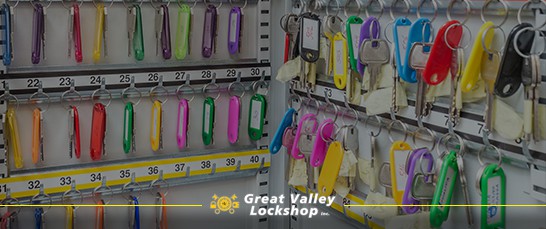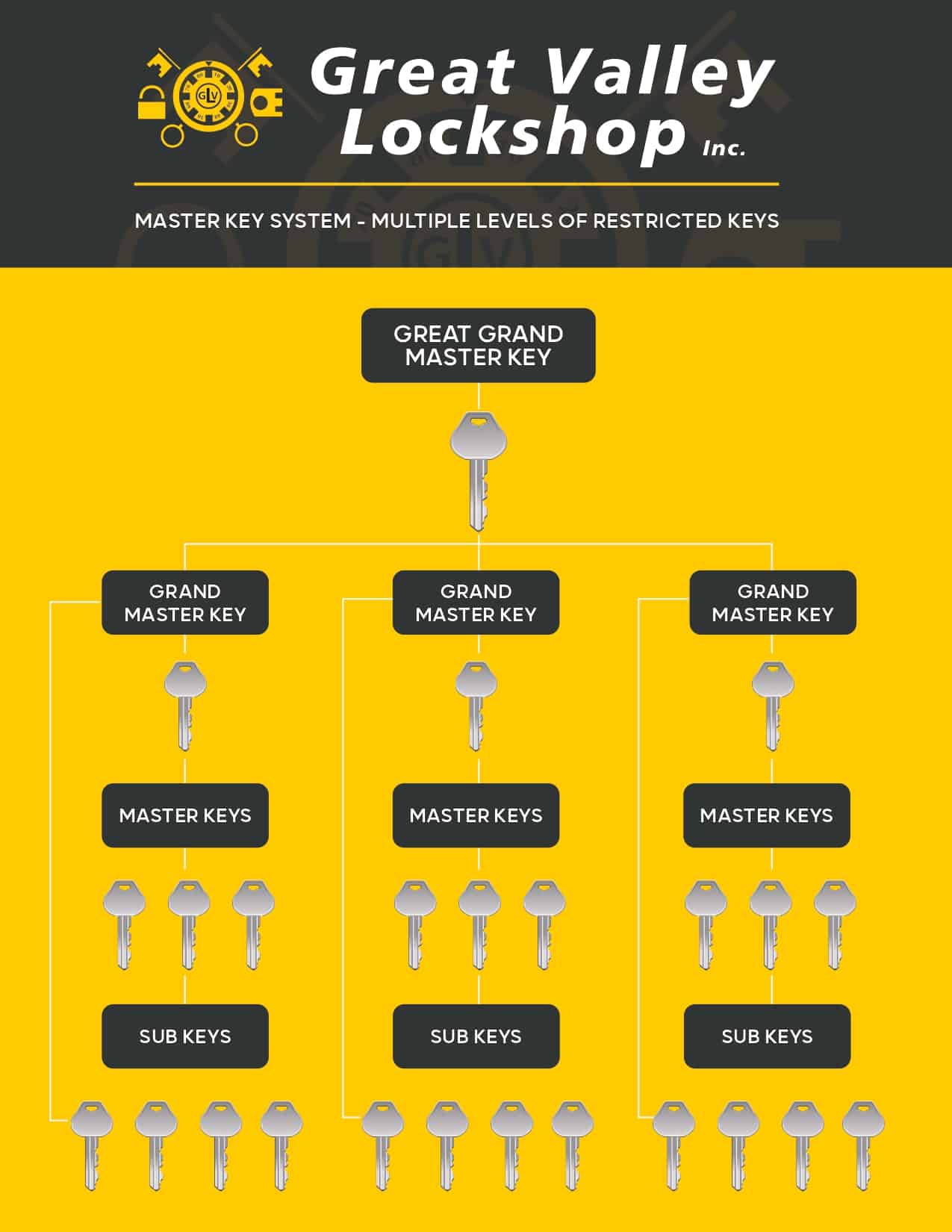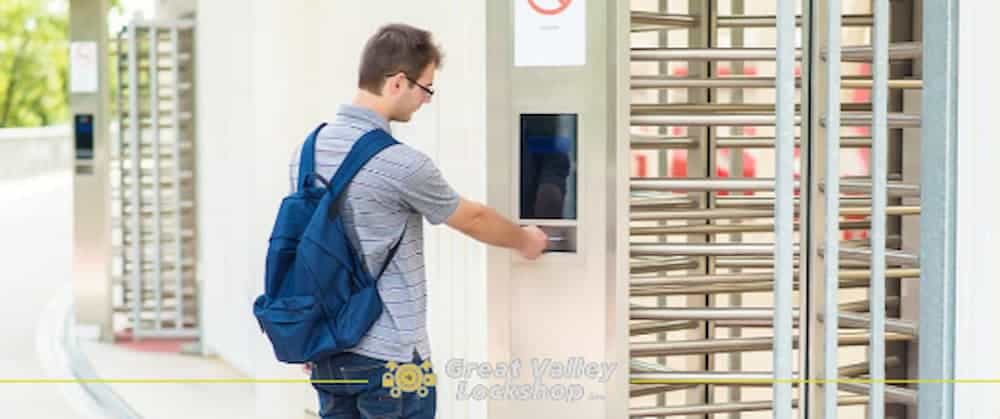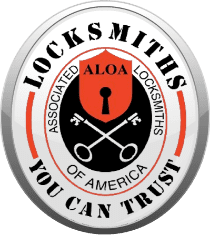
Guide to Master Key Systems and Commercial Key Management
For being so small, keys play a large part in the overall security of your company. Keys give us access to facilities, entire buildings, equipment, machinery, vehicles, and secure areas. Proper key management is critical to commercial security and supports smooth business operations.
Though an increasing number of companies are upgrading to electronic access control systems, many facilities still rely on traditional keys. Learn how you can ensure access for employees with different levels of authorization while maintaining a high level of security for your commercial facility. Here, we explain how master key systems and key management operations work together to achieve these goals.
Implementing a Master Key System
From greatest access to least, we’ve described the keys you may use within your master key system here:
- Great Grand Master Key – This key will open all subsequent key systems under it, including grand master, master, and change keys.
- Grand Master Key – This key will give you access to the multiple master keys and the subsequent change keys under those.
- Master Key – The master key is able to lock and unlock all of the change key locks prioritized below it within a given system.
- Change Key – Also referred to as a sub-master key, this key will open only one lock. The change key’s corresponding lock can also be opened by the master key.

How Master Key Systems Work
At a very basic level, you need to know that a master key system allows two or more keys to open one lock. To make this system work, pin tumbler locks are often used. These pin tumbler locks include a driver pin and a key pin. When the appropriate key is inserted, both pins are lifted so that they rest on opposite sides of the shear line.
To lift the key pins to the correct height, a key must have the right set of grooves in it. Changing a standard pin tumbler to accommodate a master key system, requires adding a master wafer which is placed between the key pin and driver pin.
Advantages of Master Key Systems
These are the benefits our clients enjoy the most:
- Increased security – Master key system design allows you to give different employees different levels of security authorization and access.
- Simplified access – Cleaning staff and managers, for example, can access multiple departments and facilities with single keys, eliminating the need for heavy key rings.
Implementing a Key Management System
Standard commercial security hardware continues to be widely used today. Key management systems include logical hardware keying design, access permissions policy, tracking and storage systems for all the various keys used throughout large facilities or campuses.
Advantages of Key Management Systems
The benefits of this type of organization system are clear. Businesses can locate the key needed at a given time quickly and conveniently. Management systems make it easy to understand how to give the appropriate access permissions to any visitor, service provider, staff, faculty or facility director. This type of system also facilitates hardware maintenance, changing the locks, making replacement keys or duplicates.
Key management systems help business owners ensure that only authorized individuals are in possession of specific keys. Managers can find information about users and track down keys that have not been returned.
How Lock Organization and Key Management Systems Work Together
Master key systems can be complex and include hundreds and thousands of separate keys. Effective key management systems have four important parts that allow businesses to keep track of all the keys required to lock and unlock hardware in the facility.
- Hardware Keying Design – creating a logical order which organizes the doors in the facility and determines the level of security for each area.
- Access Permissions Policy – outlining an organizational structure for users with the appropriate access permissions or restrictions. This includes users who will hold master keys and change keys.
- Key Tracking – maintaining accurate records to track key issuance, returns, and loans, as well as the creation of duplicates.
- Key Storage – organizing the keys for every level of access and every lock included, plus duplicates and emergency backup copies.
Hardware Keying Design
The first step in designing a key management system is related to the facility structure. Designing a hardware keying system involves mapping out the various entry points which will have keyed locks in the facility and creating a security hierarchy that includes each. An experienced commercial locksmith or architectural hardware consultant can help determine which entry points will allow access to the general public, restricted users, or require high-security access control.
The hardware keying design for the facility will correspond to the access permissions organization. The resulting keying chart will impact each door with a lock on the facility and determine its access level.
Access Permissions Policy
The second part of setting up a key management system applies to the key holders and users. The company will need to outline the various categories of employees, staff, visitors, and other users who will require access through the various entry points. It’s also necessary to assign access restrictions; specifically, what type of user won’t be permitted into restricted and high-security areas.
Key Tracking
Traditional keys can be stamped with unique serial numbers. Each one in the master key system should have its own number and be assigned to a particular security access level. Using serial numbers allows the business to keep a record of that key’s access permissions and track the person responsible for it.
A record should be kept of key issuances. Along with the serial number, this log will track:
- Who keys are given to,
- Who approved the access permissions,
- The dates of issuance and return.
Key Storage
Key storage cabinets provide a single secure place where keys, duplicates and backup copies can be kept. There are different storage cabinet styles available depending on the number of keys included in the facility structure. These cabinets make it possible to locate keys quickly, identify which keys are missing or need to be returned, and track who is responsible for each.
Many companies are now turning to electronic key management systems. These cabinets are used for safe key storage, as they are made of steel and require an entry code or proximity access card in order to unlock the door. In addition, they also keep a time-stamped digital record of key issuances and users. Advanced features include automatic notifications when keys aren’t returned on time.
Key Management Tips for Effective Commercial Security
This is our advice to office buildings and commercial businesses looking to make security tighter by using a key management system.
- Every company should develop its own policies for key issuance and requesting access permissions. These policies should be enforced at all times.
- Access privileges should be given to employees based on everyday work needs and not exceptions. This will help keep security tight. Then, with a clear access request procedure, staff can gain higher-level permissions when necessary for work purposes.
- Staff should be required to turn in their key and/or access card upon leaving the company.
- Staff should be required to report lost or stolen keys immediately.
- Only authorized staff members should be allowed to have duplicate keys made when needed.
Get more expert advice here: How to Increase Commercial Security.
If you are interested in a key management system for your commercial facility or university campus, Great Valley Lockshop is here to provide you with professional suggestions and help find the perfect management system. Call us at (610) 644-5334 or request a free quote online to learn more about your commercial security options.








